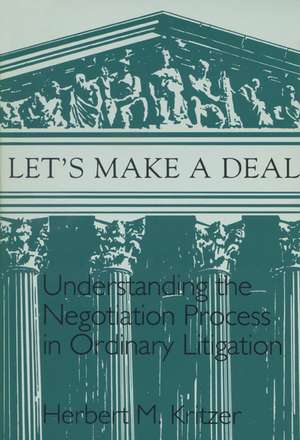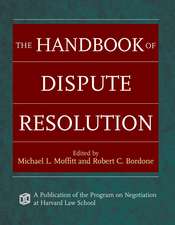Lets Make A Deal: Understanding The Negotiating Process
Autor Herbert M. Kritzeren Limba Engleză Paperback – 14 apr 1991
Americans have a long-standing reputation for relying upon the legal system to deal with all manner of problems and issues; litigiousness is often seen as an American disease. Yet 99% of legal cases started in the courts never even make it through the courthouse door, because formal court action is never initiated. Instead, participants reach an out-of-court settlement. What does this dominance of negotiated settlement over adjudication mean? Has “Equal Justice Under Law” given way to “Let’s Make a Deal”? So far, most of the evidence from judges and lawyers, policy makers and researchers has been anecdotal, and the public image of complex legal machinations and back-room deals derives from a few spectacular and atypical cases.
Based on findings from the Civil Litigation Research Project, begun in 1979 and sponsored by the U.S. Department of Justice, Herbert Kritzer has constructed a coherent picture of the routine of ordinary litigation. He shows, for instance, that the vast bulk of “ordinary cases” that account for most claims in federal and state courts are rather “cut-and-dried” affairs that deal with relatively modest amounts of money—important information for the proponents of litigation reform. He examines the economics of bargaining, for both lawyers and their clients, and the extent to which litigation is governed by monetary concerns. Evaluating the models of negotiation and game theory that are currently in vogue, Kritzer posits a more useful typology for understanding what actually happens when lawyers, plaintiffs, and defendants sit down to “make a deal.” His illuminating insights into the divergent interests of attorneys and clients correct many of the assumptions of standard economic theories of litigation and bargaining.
Based on findings from the Civil Litigation Research Project, begun in 1979 and sponsored by the U.S. Department of Justice, Herbert Kritzer has constructed a coherent picture of the routine of ordinary litigation. He shows, for instance, that the vast bulk of “ordinary cases” that account for most claims in federal and state courts are rather “cut-and-dried” affairs that deal with relatively modest amounts of money—important information for the proponents of litigation reform. He examines the economics of bargaining, for both lawyers and their clients, and the extent to which litigation is governed by monetary concerns. Evaluating the models of negotiation and game theory that are currently in vogue, Kritzer posits a more useful typology for understanding what actually happens when lawyers, plaintiffs, and defendants sit down to “make a deal.” His illuminating insights into the divergent interests of attorneys and clients correct many of the assumptions of standard economic theories of litigation and bargaining.
Preț: 89.23 lei
Nou
Puncte Express: 134
Preț estimativ în valută:
17.07€ • 17.87$ • 14.21£
17.07€ • 17.87$ • 14.21£
Carte disponibilă
Livrare economică 10-24 martie
Preluare comenzi: 021 569.72.76
Specificații
ISBN-13: 9780299128241
ISBN-10: 0299128245
Pagini: 220
Dimensiuni: 152 x 229 x 13 mm
Greutate: 0.3 kg
Ediția:New.
Editura: University of Wisconsin Press
Colecția University of Wisconsin Press
ISBN-10: 0299128245
Pagini: 220
Dimensiuni: 152 x 229 x 13 mm
Greutate: 0.3 kg
Ediția:New.
Editura: University of Wisconsin Press
Colecția University of Wisconsin Press
Notă biografică
Herbert M. Kritzer is professor of political science at the University of Wisconsin–Madison.
Descriere
Americans have a long-standing reputation for relying upon the legal system to deal with all manner of problems and issues; litigiousness is often seen as an American disease. Yet 99% of legal cases started in the courts never even make it through the courthouse door, because formal court action is never initiated. Instead, participants reach an out-of-court settlement. What does this dominance of negotiated settlement over adjudication mean? Has “Equal Justice Under Law” given way to “Let’s Make a Deal”? So far, most of the evidence from judges and lawyers, policy makers and researchers has been anecdotal, and the public image of complex legal machinations and back-room deals derives from a few spectacular and atypical cases.
Based on findings from the Civil Litigation Research Project, begun in 1979 and sponsored by the U.S. Department of Justice, Herbert Kritzer has constructed a coherent picture of the routine of ordinary litigation. He shows, for instance, that the vast bulk of “ordinary cases” that account for most claims in federal and state courts are rather “cut-and-dried” affairs that deal with relatively modest amounts of money—important information for the proponents of litigation reform. He examines the economics of bargaining, for both lawyers and their clients, and the extent to which litigation is governed by monetary concerns. Evaluating the models of negotiation and game theory that are currently in vogue, Kritzer posits a more useful typology for understanding what actually happens when lawyers, plaintiffs, and defendants sit down to “make a deal.” His illuminating insights into the divergent interests of attorneys and clients correct many of the assumptions of standard economic theories of litigation and bargaining.
Based on findings from the Civil Litigation Research Project, begun in 1979 and sponsored by the U.S. Department of Justice, Herbert Kritzer has constructed a coherent picture of the routine of ordinary litigation. He shows, for instance, that the vast bulk of “ordinary cases” that account for most claims in federal and state courts are rather “cut-and-dried” affairs that deal with relatively modest amounts of money—important information for the proponents of litigation reform. He examines the economics of bargaining, for both lawyers and their clients, and the extent to which litigation is governed by monetary concerns. Evaluating the models of negotiation and game theory that are currently in vogue, Kritzer posits a more useful typology for understanding what actually happens when lawyers, plaintiffs, and defendants sit down to “make a deal.” His illuminating insights into the divergent interests of attorneys and clients correct many of the assumptions of standard economic theories of litigation and bargaining.













